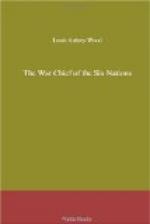In August of the same year, 1780, Brant again invaded the Mohawk valley. On this occasion he gained his object by an artful device. He learned that some stores were being borne to Fort Schuyler and pretended that he was going to seize them and attack the fort itself. The local militia marched to the fort’s defence and, while they were intent on this, Brant doubled back to the rear. Swooping down upon the white settlement at Canajoharie, he laid everything low and carried away captive many women and children. Later in the season he made a similar descent into the Schoharie-kill, but here there is on record to his credit at least one act of kindness. After the raid, a group of settlers were gathered together, telling of all the mishaps that had occurred to them. One sad-eyed woman told of the loss of her husband and several of her children. She had been bereft even of an infant, which had been torn from its cradle. But that morning, while the officers of the colonial camp were seated at their breakfast, a painted redskin sprang into their midst carrying in his arms a slender child and handed a letter to the officer in command. It was the woman’s child that he bore, and the letter was from Joseph Brant.
‘Sir,’ ran the epistle, ’I send you by one of my runners the child which he will deliver, that you may know that whatever others do, I do not make war upon women and children. I am sorry to say that I have those engaged with me in the service who are more savage than the savages themselves.’
The year 1781 brought the war to its climax. On October 19 Lord Cornwallis, hard pressed at Yorktown by an army of sixteen thousand men under Washington and a powerful French fleet under Admiral de Grasse, was forced to surrender. This was the last important episode before peace was arranged. During the summer the War Chief had still been fighting on the border and harassing the country of those who sympathized with the Americans. In August he was found in the west, having defeated a part of Colonel Clark’s forces near the Great Miami river, which empties into Lake Erie.
The treaty of peace between Great Britain and the United States of America was signed in November 1782. Canada, Newfoundland, and what are now the Maritime Provinces of the Dominion remained in the hands of the crown, but the independence of the other English colonies in the New World was recognized. In the whole text of the treaty there was not a word about the Six Nations. But all their lands south of Lake Ontario as far as the banks of the Hudson came into the possession of the United States. For some time it seemed as though the Indians’ sacrifices on behalf of His Majesty the King were to be reckoned as nothing, and the tribesmen who had been loyal were very wroth. They had fought valiantly for the crown, and now expected that the king should do something for them in return. All that they had to fall back upon was the promise that their rights would be respected when the conflict ended.




